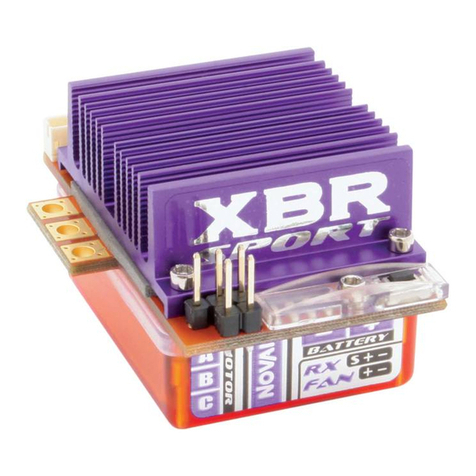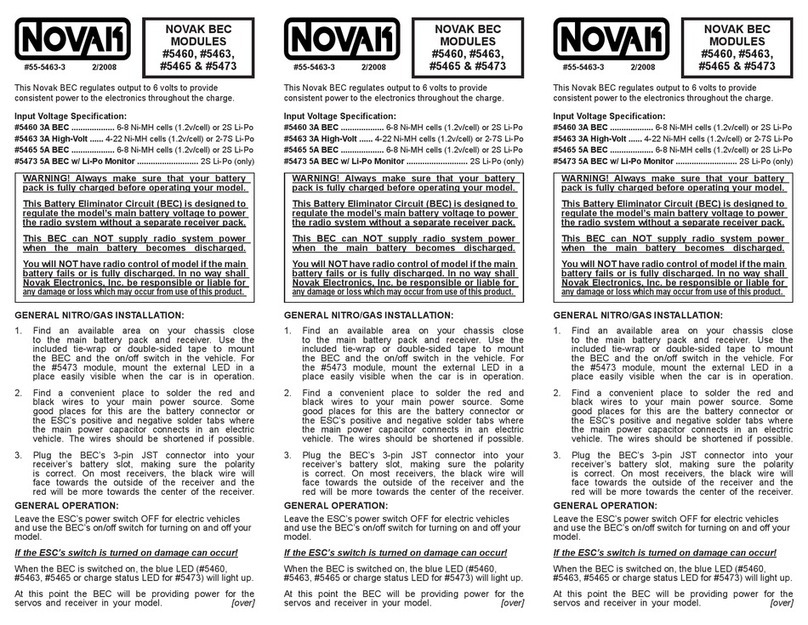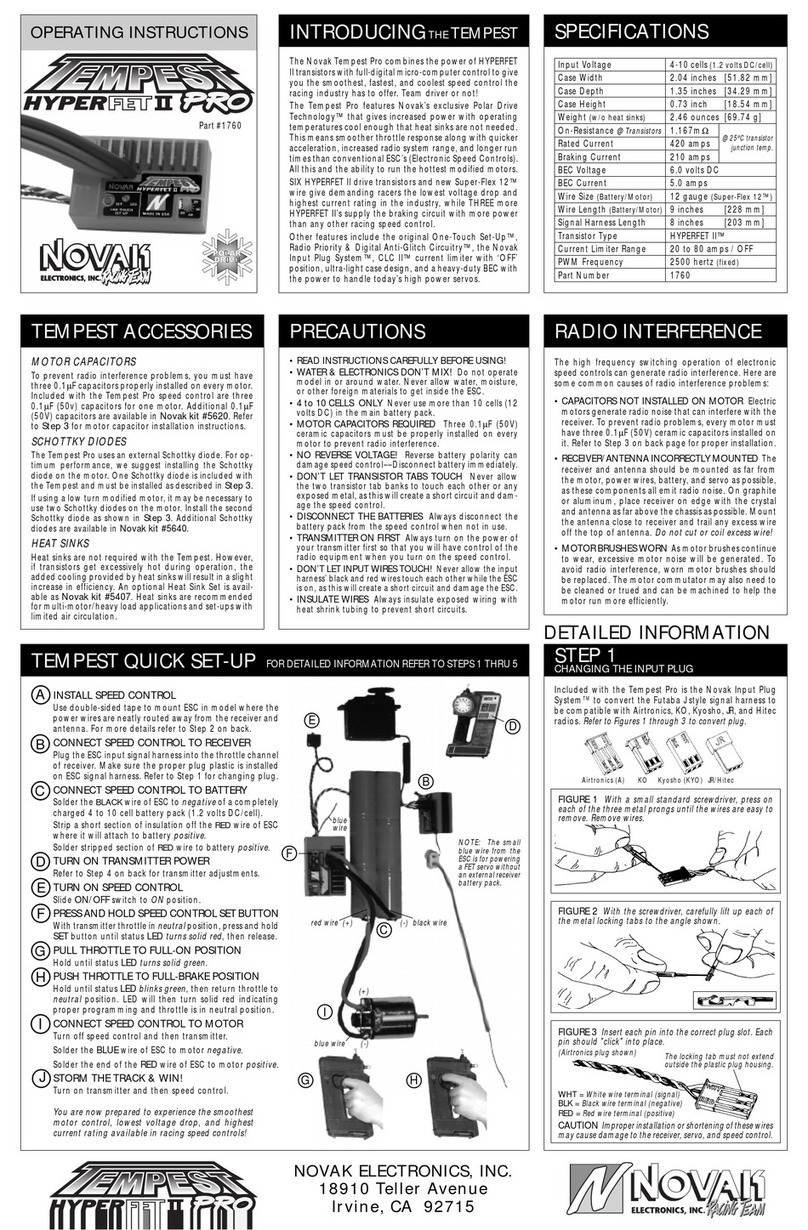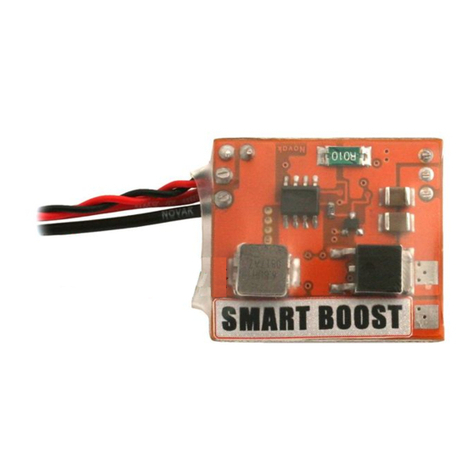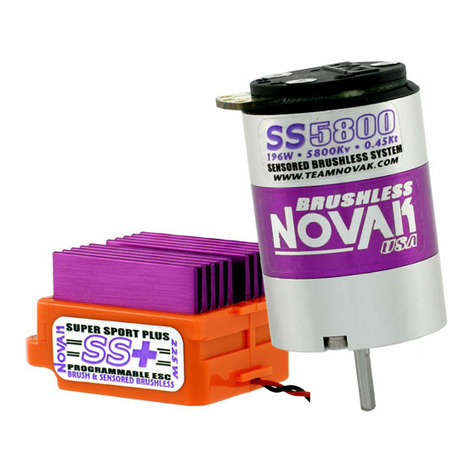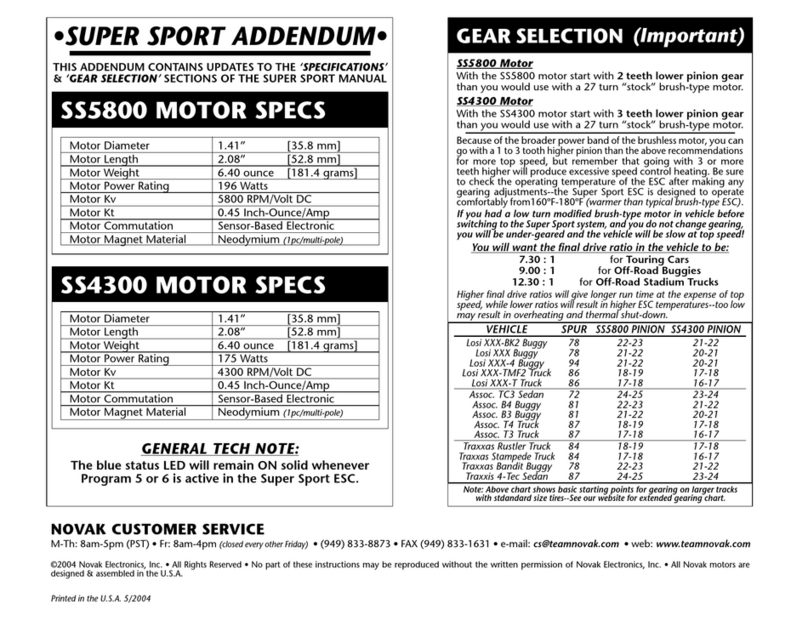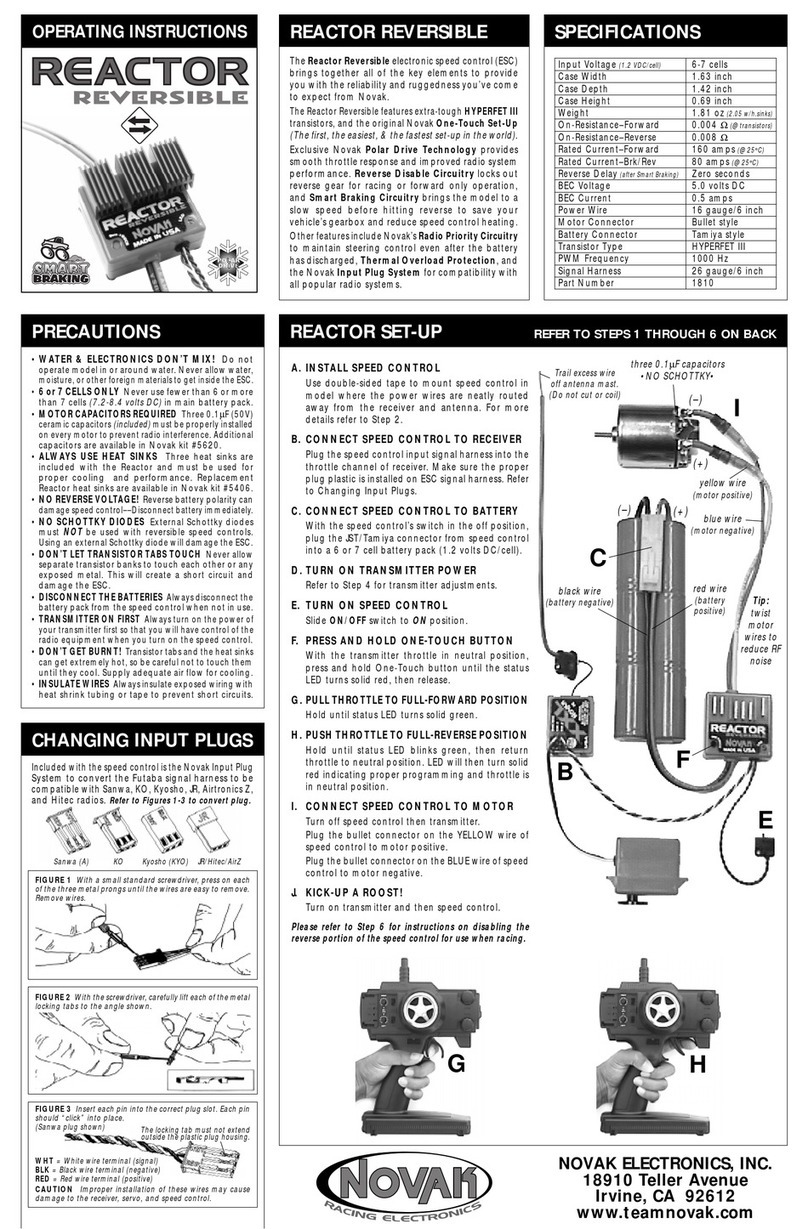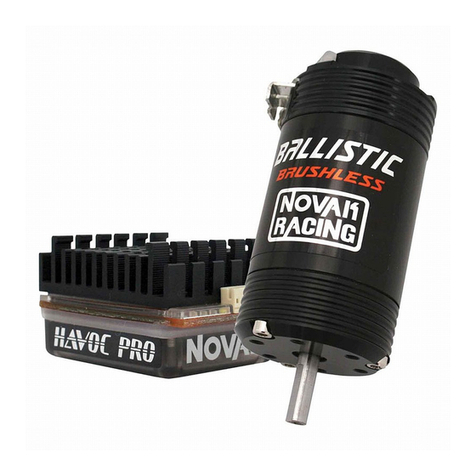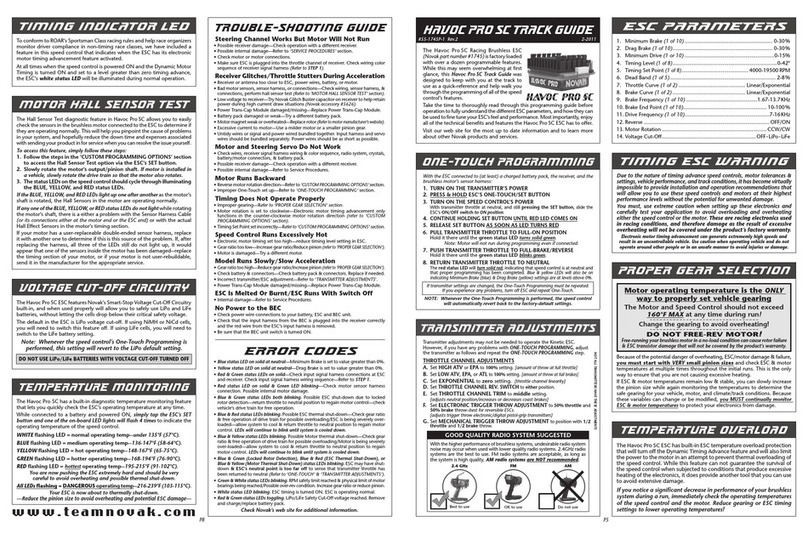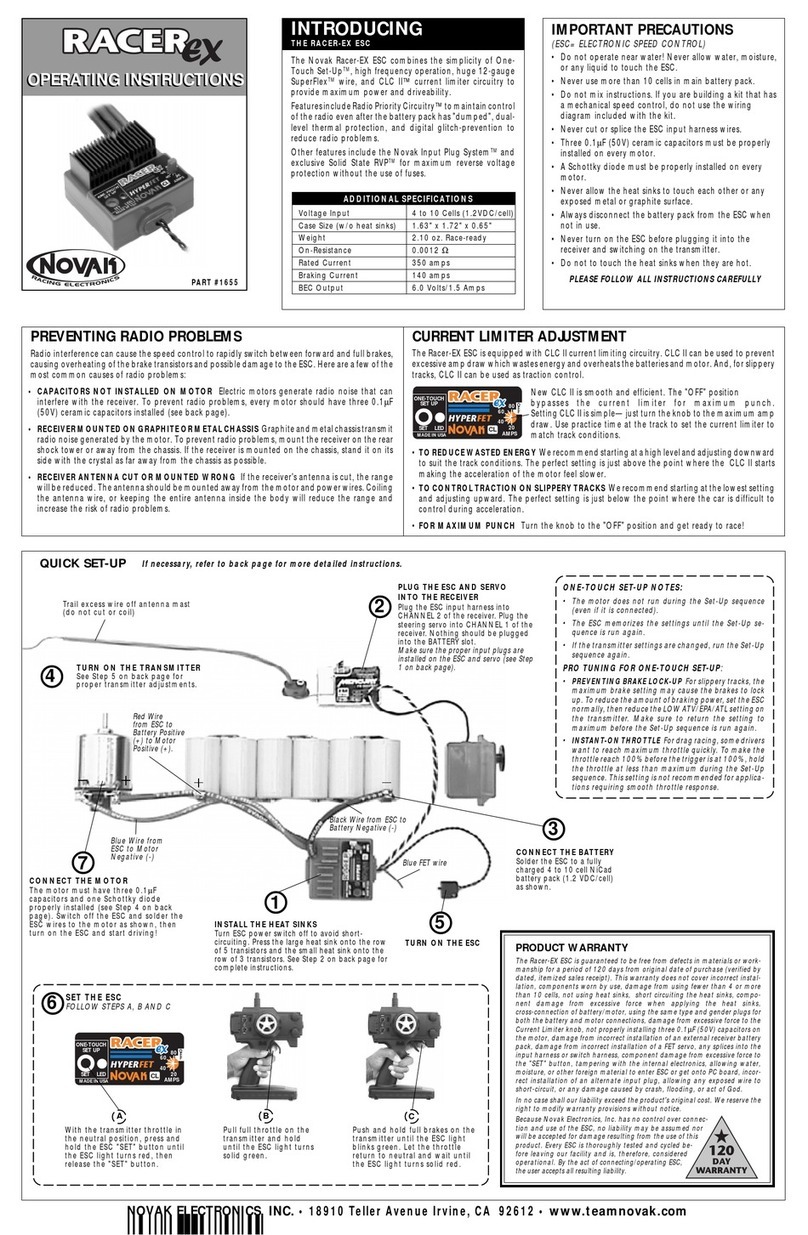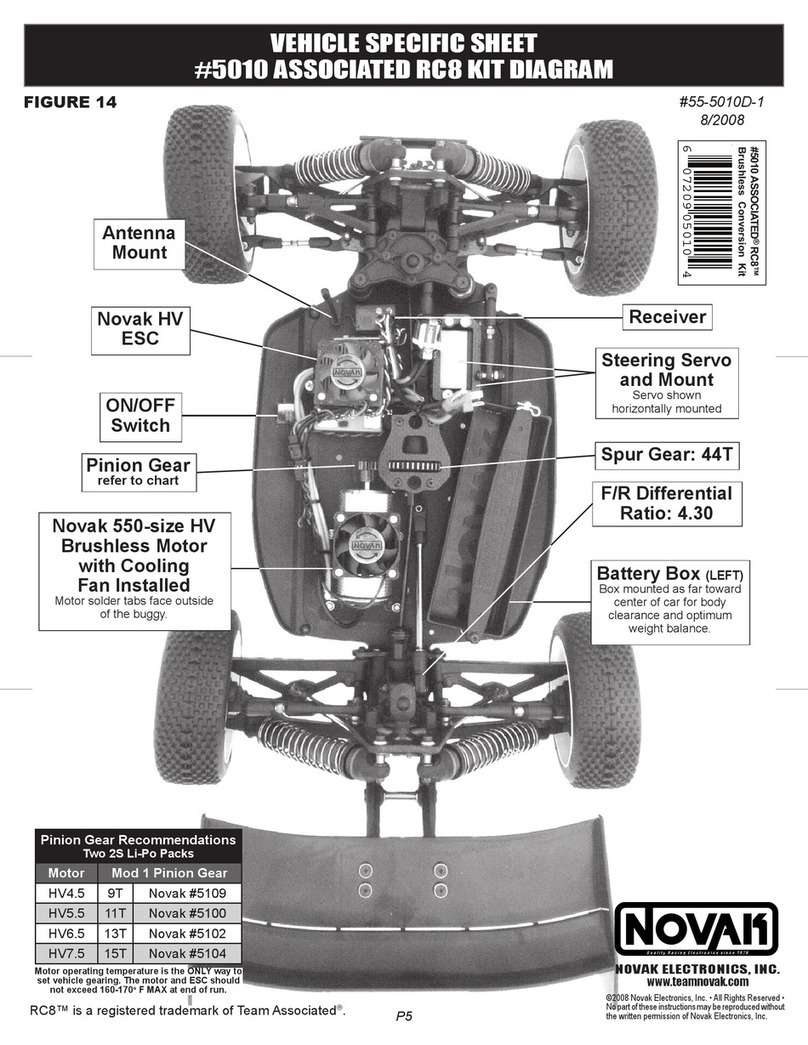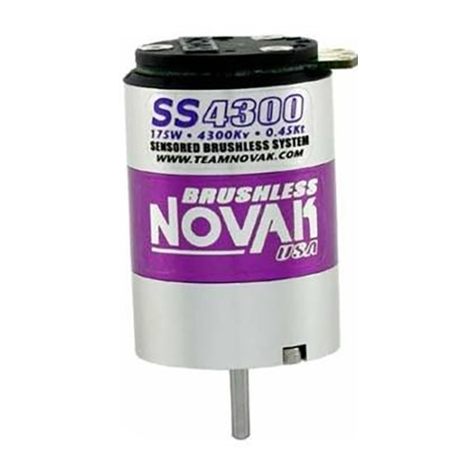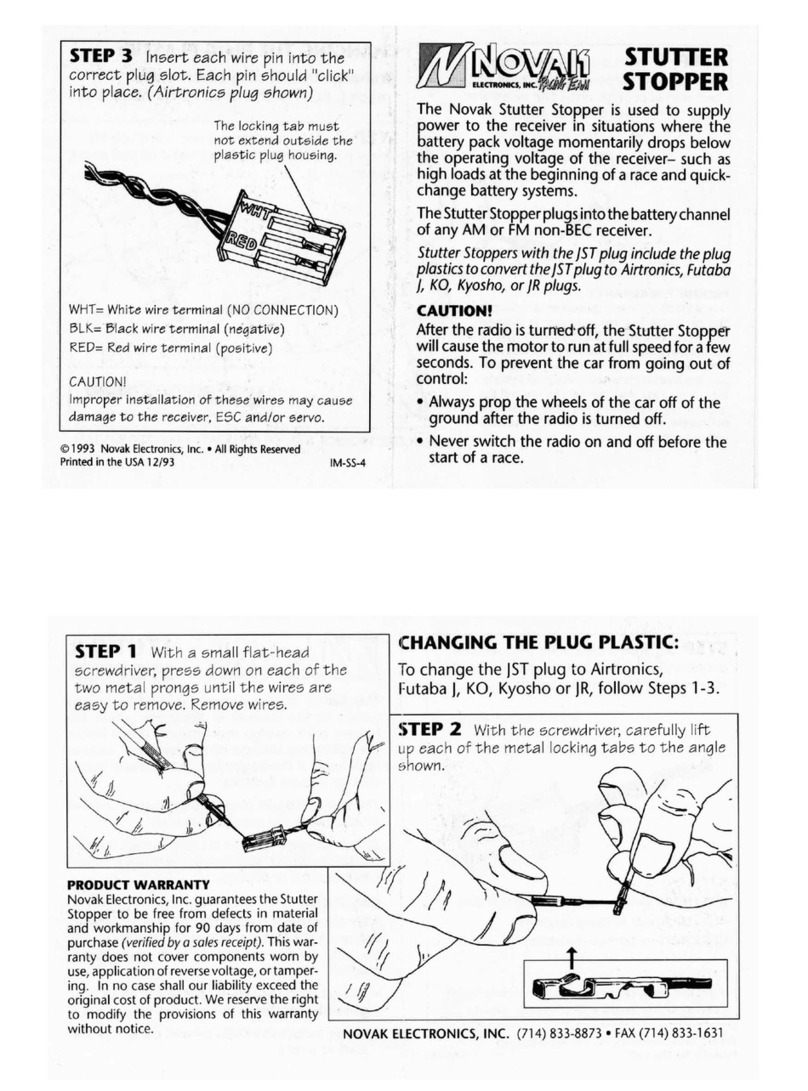#55-1705-1
2-2005
SPECIFICATIONS
Input Voltage.......................................... 4-7 cells (1.2 volts DC/cell)
ESC Case Size ......................
1.32”x1.75”x1.05” [33.5x44.4x26.7mm]
ESC Weight (w/o wires) .................................... 1.70 ounce [48.2 grams]
B.E.C. Voltage/Current...............................6.0 volts DC/3.0 amps
Power Wire (Battery/Motor) ............................ 14G Super-Flex Silicone
On-Resistance
(Brushless-Mode) ..................
0.0019Ω
@25°C trans.temp.
On-Resistance
(Brush-Mode) .......................
0.0006Ω
@25°C trans.temp.
Rated Current (Brushless-Mode) .......
160A
[Fwd & Rev.]
@25°C trans.temp.
Rated Current (Brush-Mode) .........
480A
[Fwd & Brakes]
@25°C trans.temp.
Motor Limit (Brushless-Mode) .....................
225 watts
@25°C trans.temp.
Motor Limit (Brush-Mode) .......................................................
12-turn
Throttle Programs
(Brushless-Mode) ..............
5
[3 w/Rev. & 2 Fwd/Brake]
Throttle Program
(Brush-Mode) .......................................
1
[Fwd/Brake]
Brush & brushless motor control and programmability all in one!
The Super Sport Plus programmable electronic speed control gives you the best of both worlds--brush & sensor-based brushless motor control.
Combine this with on-board programming of Minimum Drive, Minimum Brake, Drag Brake, & Deadband, and you’ve got extreme versatility.
The Super Sport Plus is factory-loaded with 6 throttle programs to choose from (including a limited reverse Marine Mode), Novak’s Smart Braking II (you
don’t go into reverse until you shift into reverse by returning the trigger to neutral and then back to reverse), Thermal Overload Protection, high-power B.E.C. for
strong/fast servo response, Polar Drive & Digital Anti-Glitch circuitries for cool & smooth operation, and Radio Priority circuitry for the ultimate in control,
right down to the end of the charge. Add to this the user-replaceable battery wires, power capacitor, & input harness, and the Super Sport Plus has it all!
To benefit from all of the technical features of the Super Sport Plus, PLEASE READ ALL INSTRUCTIONS
REPLACEMENT POWER CAPACITOR [Novak kit #5677]
The Super Sport Plus comes with a factory-installed Power Capacitor, and
MUST BE USED to maintain cool and smooth operation. Direct-replacement
Super Sport Plus Power Capacitor is available in Novak kit #5677.
Note: We highly recommend using Novak Power Capacitors, as we have done
extensive testing & research to find Power Capacitors with the very best quality
factors––other capacitors with similar ratings will not provide equal protection.
SUPER-FLEX SILICONE 14G WIRE
[Novak kits #5500 & 5508]
Novak Super-Flex wire for power wiring. 14 gauge silicone wire in kit #5500
(36”red & 36”black)
and kit #5508
(2 each of 9”red/black/blue/yellow/orange)
.
INPUT SIGNAL HARNESS [Novak kits #5315 & 5320]
User-replaceable input signal harness is available in both short and long
lengths. 4.5” harness in Novak kit#5315, and 9.0” harness in Novak kit #5320.
SS-SERIES MOTOR END BELL & BEARING SET
After extensive use, the ball bearings in the end bells of your brushless mo-
tor may need to be replaced. Replacement front end bell with bearing factory-
installed & rear bearing are available in Novak kit #5905.
WATER & ELECTRONICS DON’T MIX!
Never allow water, moisture, or other foreign materials to get inside
ESC, motor, or on the PC Boards. Water damage will void the warranty!
NO SCHOTTKY IN BRUSHLESS-MODE!
Schottky diodes must NOT be used when using ESC in Brushless-Mode
(Schottky diodes are never used with reversible ESCs, including brushless).
Schottky diode usage in Brushless-Mode willdamage ESC & void warranty.
TAKE CARE WHEN SWITCHING ESC MODES
Severe ESC damage can occur if proper procedures are not followed
when switching ESC between Brush-Mode & Brushless-Mode.
Refer to PROGRAMMING/GEARING sheet page 5 for detailed instructions.
DISCONNECT BATTERIES WHEN NOT IN USE
Always disconnect the battery pack from the speed control when not
in use to avoid short circuits and possible fire hazard.
4 TO 7 CELLS ONLY
Never use fewer than 4 or more than 7 cells (4.8-8.4VDC, 1.2VDC/cell)
in the vehicle’s main battery pack(s).
NOVAK BRUSHLESS MOTORS ONLY
The Super Sport Plus ESC is specially designed for use with sensor-
based Novak SS-Series Brushless Motors Only! You may replace motor
with Novak sensored motor rated up to 225W (ESC’s rating).
At the time of printing, there are no other brushless motor’s available that work
with the Super Sport Plus––check our website for further updates & compatibilities.
NO REVERSE VOLTAGE!
Reverse battery polarity can damage ESC & void warranty. Disconnect
battery immediately if a reverse connection occurs.
POWER CAPACITOR REQUIRED
An external power capacitor is installed and MUST be used with your
ESC. Failure to use Power Capacitor will result in higher ESC operating
temperatures & possible thermal shut-down.
TRANSMITTER ON FIRST
Always turn on the power of the transmitter first so that you will have
control of the vehicle when you turn it on.
INSULATE WIRES
Always insulate exposed wiring with heat shrink tubing or electrical
tape to prevent short circuits, which can damage ESC.
NO CA GLUE
Exposure to CA glue or its fumes can cause damage to internal
components of the speed control and result in premature failure.
With ESC connected to (at least) a receiver & a charged battery pack:
1. TURN ON THE TRANSMITTER’S POWER
2. PRESS & HOLD ESC’S ONE-TOUCH/SET BUTTON
3. TURN ON THE SPEED CONTROL’S POWER
With transmitter throttle at neutral, and still pressing the
SET button,
slide the ESC’s ON/OFF switch to ON position.
4.
CONTINUE HOLDING SET BUTTON UNTIL RED LED COMES ON
5. RELEASE SET BUTTON AS SOON AS LED TURNS RED
6.
PULL TRANSMITTER THROTTLE TO FULL-ON POSITION
Hold it there until the green status LED turns solid green.
Note: Motor will not run during programming even if connected.
7. PUSH TRANSMITTER THROTTLE TO FULL-BRAKES
Hold it there until the green status LED blinks green.
8. RETURN TRANSMITTER THROTTLE TO NEUTRAL
Red status LED will turn solid red, indicating that speed control is at
neutral and that proper programming has been completed.
NOTE: If transmitter settings are changed, One-Touch Programming must be
repeated. If you experience any problems, turn off ESC & repeat One-Touch.
REMEMBER: Whenever One-Touch set-up is performed, ESC automatically reverts to
factory default settings & the Throttle Profile reverts to #1 when in Brushless-Mode.
trouble-shooting guidetrouble-shooting guide
Steering Channel Works But Motor Will Not Run
•Red status LED blinking when throttle is applied. Check motor sensor harness
connection at ESC (make sure all metal sockets are fully inserted into the connector’s
plastic housing)––check for damaged wires.
•Red status LED on solid & Green LED blinking. Check input signal harness & motor
sensor harness connections at ESC. Check input signal harness wiring sequence &
connection at throttle channel of receiver. Check throttle channel operation with servo.
Motor sensor harness connected while in Brush-Mode––disconnect sensor harness.
•Blue & Green status LEDs both blinking. Possible ESC shut-down due to locked rotor
detection––return throttle to neutral position to regain motor control––check vehicle’s
drive train for free operation.
•Blue & Red status LEDs blinking. Possible ESC thermal shut-down––Check gear ratio
& free operation of drive train for possible overloading/ESC is being severely over-
loaded––allow system to cool & return throttle to neutral position to regain motor
control. LEDs will continue to blink until system is cooled down.
•Blue & Amber status LEDs blinking. Possible motor thermal shut-down––Check gear
ratio & free operation of drive train for possible overloading/motor is being over-
loaded––allow system to cool & return throttle to neutral position to regain motor
control. LEDs will continue to blink until system is cooled down.
•Blue & Green (Locked Rotor Detection), Blue & Red (ESC Thermal Shut-Down), or
Blue & Amber (Motor Thermal Shut-Down) status LEDs blinking. ESC may have shut-
down & ESC’s neutral point is too far off to sense that transmitter throttle has
been returned to neutral––Refer to Steps 4 & 5.
• Possible receiver damage––Check operation with a different receiver.
• Possible internal damage––Refer to Service Procedures.
Receiver Glitches/Throttle Stutters During Acceleration
• Receiver or antenna too close to ESC, power wires, battery, or motor.
• Bad connections––Check wiring, connectors, & sensor harness.
• External Power Capacitor damaged/not installed––Replace Power Capacitor.
Motor and Steering Servo Do Not Work
• Check wires, receiver signal harness wiring & color sequence, radio system, crystals,
battery/motor connectors, & battery pack.
• Possible receiver damage––Check operation with a different receiver.
• Possible internal damage––Refer to Service Procedures.
Speed Control Runs Excessively Hot
• Gear ratio too low––Increase gear ratio (see ‘GEAR SELECTION’).
Model Runs Slowly/Slow Acceleration
• Gear ratio too high––Reduce gear ratio (see ‘GEAR SELECTION’).
• Check battery connectors––Replace if needed.
• Incorrect transmitter/ESC adjustment––Refer to Steps 4 & 5.
• External Power Capacitor damaged/not installed––Replace Power Capacitor.
ESC Is Melted Or Burnt/ESC Runs With Switch Off
• Internal damage––Refer to Service Procedures.
*For more assistance call our Customer Service Department or check our website.
service proceduresservice procedures
Before sending your speed control or brushless motor system in for
service, review Trouble-Shooting guide and instructions. System may
appear to have failed when other problems exist.
After reviewing instructions, if you feel that your ESC/system requires
service, please obtain the most current product service options and
pricing by the following ways:
WEBSITE:
Print a copy of the PRODUCT SERVICE FORM from the CUSTOMER SERVICE
section of the website. Fill out the needed information on this form and return it with
the Novak product that requires servicing.
PHONE/FAX: If you do not have access to the internet, please contact our customer
service department by phone or fax as listed below.
WARRANTY SERVICE:
For warranty work, you MUST CLAIM WARRANTY on
PRODUCT
SERVICE FORM & include a valid cash register receipt with purchase
date
and dealer name & phone# on it, or an invoice from previous service. If warranty
provisions have been voided, there will be service charges.
•ESCs returned without a serial number will not be serviced under warranty•
ADDITIONAL NOTES:
•
Dealers/distributors are not authorized to replace Novak products thought to be defective.
• If a hobby dealer returns your brushless system for service, submit a completed
PRODUCT SERVICE FORM to the dealer and make sure it is included with the product.
• Novak Electronics, Inc. does not make any internal electronic components (transistors,
resistors, etc.) available for sale.
Novak Electronics, Inc.
(949) 833-8873 • FAX (949) 833-1631
Monday-Thursday: 8:00am-5:00pm (PST)
Friday: 8:00am-4:00pm
(closed every other Friday)
www.teamnovak.com
super sport plus
--
INstructIons
PRECAuTIONS
optional accessories
P1P4
sensor harness wiringsensor harness wiring
sensor harness wiringsensor harness wiring
sensor harness wiring
Should any of the 26G Teflon wires pull out of the connector on the
end of the motor’s sensor harness, re-insert them in the appropriate
slot in the connector as shown below. There is a small plastic tab that
grabs a small raised barb on the back of the metal socket crimped onto
the Teflon wire’s end. The plastic tab should be checked to make sure it
has not deformed excessively before inserting the metal socket into the
plastic connector housing with the barb toward to plastic tabs.
If the motor’s
sensor harness
gets damaged,
please contact
our Customer
Service Dept.
stepstep
stepstep
step 55
55
5
–
one-touch programming
For proper ESC operation, adjust transmitter as follows:
A. Set HIGH ATV or EPA to maximum setting.
[amount of throw at full throttle]
B. Set LOW ATV, EPA, or ATL to maximum setting.
[amount of throw at full brakes]
C. Set EXPONENTIAL to zero setting. [throttle channel linearity]
D.
Set THROTTLE CHANNEL REV. SWITCH to either position.
E. Set THROTTLE CHANNEL TRIM to middle setting.
[adjusts neutral position/increases or decreases coast brakes]
F.
Set ELECTRONIC TRIGGER THROW ADJUSTMENT to 70%
throttle and 30% brake throw (or 7:3)--best for reversible ESCs.
[adjusts trigger throw electronic/digital pistol-grip transmitters]
G.
Set MECHANICAL TRIGGER THROW ADJUSTMENT to position
with 1/2 throttle and 1/2 brake throw.
[adjusts trigger throw on mechanical/analog pistol-grip transmitters]
•NOT ALL TRANSMITTERS HAVE THESE ADJUSTMENTS
•
stepstep
stepstep
step 44
44
4
–transmitter adjustments
using a receiver battery packusing a receiver battery pack
using a receiver battery packusing a receiver battery pack
using a receiver battery pack
If you are planning to use an external receiver battery pack to power the
electronics you need to do the following:
1. Plug the external 5 cell (1.2VDC/cell) receiver battery pack into the
battery slot of the receiver.
2. Leave the ESC’s ON/OFF switchin the OFF position, and use receiver
battery pack’s ON/OFF switch to turn the system power on and
off––Do not use the ESC’s switch.
product warrantyproduct warranty
The Super Sport Plus Brushless ESC is guaranteed to be free from defects in materials or workmanship for a
period of 120 days from the original date of purchase (verified by dated, itemized sales receipt). Warranty does
not cover incorrect installation, components worn by use, damage to case or exposed circuit boards, damage
from using fewer than 4 or more than 7 cells (1.2 volts DC/cell) input voltage, cross-connection of battery/
motor power wires, overheating solder tabs, reverse voltage application, damage resulting from thermal overload
or short-circuiting motor (or connecting a brushless motor sensor harness while operating in Brush-Mode),
damage from incorrect installation of FET servo or receiver battery pack, not using or incorrect installation of a
Power Capacitor on the ESC or from using a damaged Power Capacitor, using a Schottky diode in Brushless-
Mode, using non-Novak Power Capacitor or motor, splices to input, ON/OFF switch, or sensor harnesses,
damage from excessive force when using the One-Touch/SET button or from disassembling case, tampering
with internal electronics, allowing water, moisture, or any other foreign material to enter ESC or get onto the
PC board, incorrect installation/wiring of input plug plastic, allowing exposed wiring or solder tabs to short-
circuit, or any damage caused by a crash, flooding, or act of God.
Because Novak Electronics, Inc. has no control over the connection & use of the speed control or other
related electronics, no liability may be assumed nor will be accepted for any damage resulting from the
use of this product. Every Novak speed control & motor is thoroughly tested & cycled before leaving our
facility and is, therefore, considered operational. By the act of connecting/operating speed control, user
accepts all resulting liability. In no case shall our liability exceed the product's original cost. We reserve the
right to modify warranty provisions without notice.
©2005 Novak Electronics, Inc. • All Rights Reserved • No part of these instructions may be reproduced
without the written permission of Novak Electronics, Inc. • Super Sport Plus ESC, Smart Braking II, Polar
Drive Technology, Radio Priority Circuitry, & One-Touch Set-Up are all trademarks of Novak Electronics,
Inc. • All Novak speed controls & motors are designed & manufactured in the U.S.A.
black
orange
white
plastic
tabs
red
blue
green
metal
barbs
raised
metal
barb
metal socket
on end of Teflon
sensor harness wires

